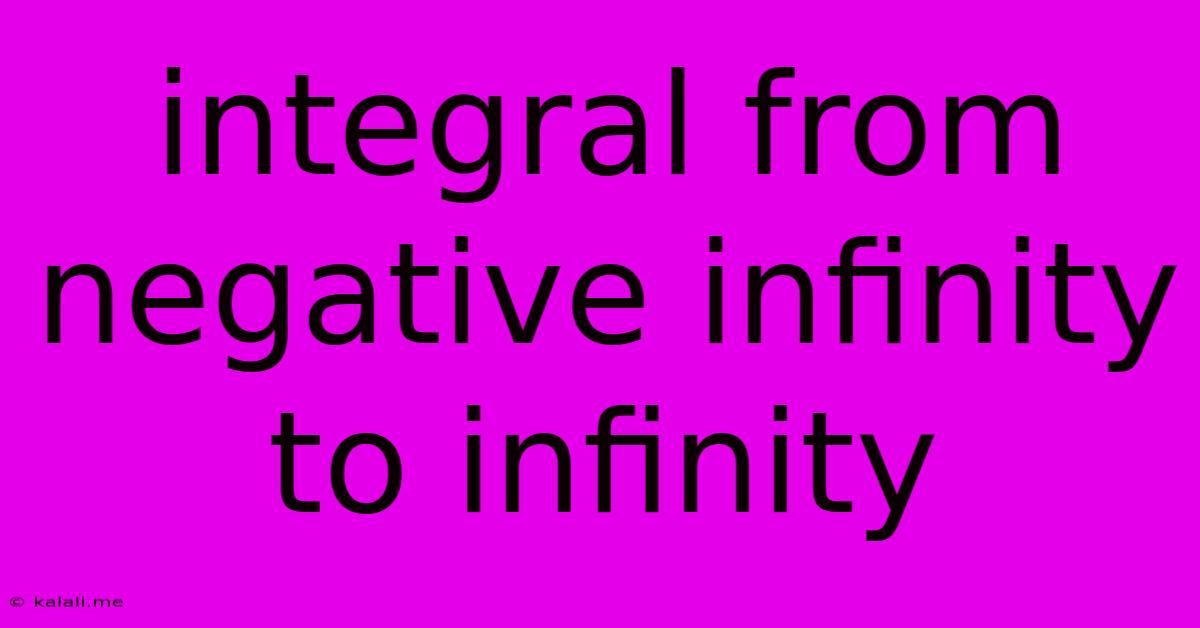Integral From Negative Infinity To Infinity
Kalali
Jun 03, 2025 · 3 min read

Table of Contents
Understanding Integrals from Negative Infinity to Infinity: A Comprehensive Guide
Meta Description: This article provides a comprehensive guide to improper integrals from negative infinity to infinity, covering their definition, properties, convergence tests, and applications in various fields. Learn how to evaluate these integrals and understand their significance in mathematics and beyond.
Improper integrals extending from negative infinity to positive infinity are a fascinating and powerful concept in calculus, frequently encountered in various fields like probability, physics, and engineering. They represent the area under a curve that stretches infinitely in both directions along the x-axis. Understanding how to evaluate these integrals and determine their convergence is crucial for many advanced applications. This article will delve into the intricacies of these improper integrals, providing a clear and comprehensive guide.
Defining Improper Integrals from Negative Infinity to Infinity
An improper integral of the form $\int_{-\infty}^{\infty} f(x) dx$ is defined as the limit of a definite integral as the bounds of integration approach infinity:
$\int_{-\infty}^{\infty} f(x) dx = \lim_{a \to -\infty} \lim_{b \to \infty} \int_a^b f(x) dx$
This definition highlights a crucial point: we evaluate the integral by taking two separate limits. We first integrate over a finite interval [a, b], and then consider what happens as 'a' approaches negative infinity and 'b' approaches positive infinity independently. The order of limits matters in some cases, so it’s essential to use this approach. If the limit exists and is finite, we say the integral converges; otherwise, it diverges.
Techniques for Evaluating Improper Integrals
Evaluating these integrals often requires a combination of techniques:
-
Direct Integration: If a direct antiderivative can be found, this is the simplest approach. After finding the antiderivative F(x), evaluate $\lim_{a \to -\infty} \lim_{b \to \infty} [F(b) - F(a)]$.
-
Substitution: Substitution can simplify the integral, making it easier to evaluate the limits.
-
Partial Fraction Decomposition: For rational functions, decomposing the integrand into partial fractions often facilitates integration and limit evaluation.
-
Comparison Test: If direct evaluation is difficult, the comparison test can determine convergence or divergence by comparing the given integral to one whose convergence is known.
-
Cauchy Principal Value: When the limit doesn't exist, the Cauchy Principal Value provides a way to assign a value to the integral. It's defined as: $PV \int_{-\infty}^{\infty} f(x) dx = \lim_{R \to \infty} \int_{-R}^{R} f(x) dx$ Note that the Cauchy Principal Value might exist even if the integral diverges.
Convergence and Divergence
The convergence or divergence of an improper integral from negative infinity to infinity hinges on the behavior of the integrand as x approaches positive and negative infinity. Several factors can influence convergence:
-
Decay Rate: If the integrand decays sufficiently fast as |x| approaches infinity (e.g., faster than 1/x²), the integral is more likely to converge.
-
Oscillations: Oscillatory behavior can hinder convergence, especially if the oscillations don't dampen as |x| increases.
-
Singularities: The presence of singularities (points where the function is undefined) within the integration interval requires special handling, often breaking the integral into multiple parts.
Applications
Improper integrals from negative infinity to infinity find extensive use in:
-
Probability Theory: Calculating probabilities involving continuous random variables. The total probability must integrate to 1 over the entire real line.
-
Physics: Solving problems involving infinite systems or fields, such as the calculation of potentials in electrostatics.
-
Signal Processing: Analyzing signals with infinite duration.
-
Quantum Mechanics: Evaluating wave functions and calculating probabilities.
Conclusion
Improper integrals from negative infinity to infinity form a critical component of advanced calculus. Mastering the techniques for evaluating these integrals and understanding their convergence behavior is vital for tackling numerous problems in various scientific and engineering disciplines. The concepts discussed here provide a solid foundation for further exploration of this crucial area of mathematics. Remember to always carefully consider the limits and potential singularities when approaching these types of problems.
Latest Posts
Latest Posts
-
How Warm Should The Milk Be To Activate The Yeast
Jun 04, 2025
-
Why Should You Have Shielded Rj45 Connectors
Jun 04, 2025
-
How To Tell If Your Rabbit Is Male Or Female
Jun 04, 2025
-
Wire Size For 30 Amp Breaker
Jun 04, 2025
-
How To Take Paint Off Tile
Jun 04, 2025
Related Post
Thank you for visiting our website which covers about Integral From Negative Infinity To Infinity . We hope the information provided has been useful to you. Feel free to contact us if you have any questions or need further assistance. See you next time and don't miss to bookmark.